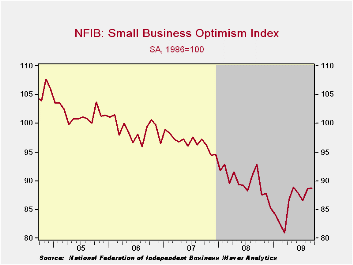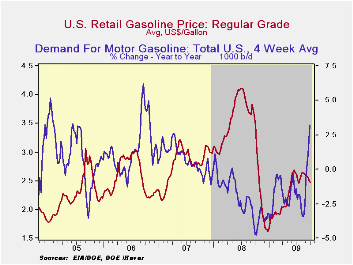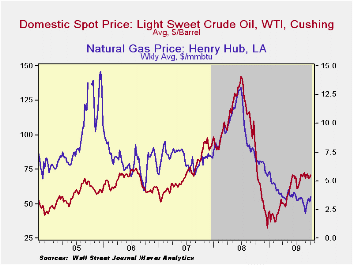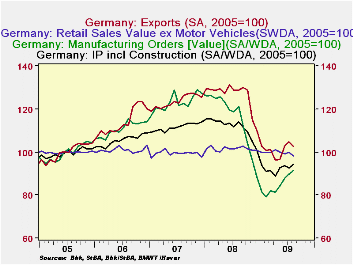 Global| Oct 13 2009
Global| Oct 13 2009U.S. Small Business OptimismImproves Slightly Again
by:Tom Moeller
|in:Economy in Brief
Summary
During September, small business' optimism inched higher for the second month as the severe economic weakness of early this year passed. The National Federation of Independent Business (NFIB) indicated their small business optimism [...]

During September, small business' optimism inched higher for the second month as the severe economic weakness of early this year passed. The National Federation of Independent Business (NFIB) indicated their small business optimism index rose to 88.8 during September after an August uptick. The index remained improved from the lows of this past winter but were down from last year.During the last ten years, there has been an 85% correlation between the level of the NFIB index and the two-quarter change in real GDP.
The percentage of small businesses expecting the economy to improve slipped back to just 8. However, despite this negativism the percentage which thought that now was a good time to expand the business rose sharply to 9 which was the highest level in twelve months. Moreover, the percent reporting higher net-earnings this quarter versus last year held at -40 m/m, meaning fewer were reporting negative earnings versus last year. It was the highest level since December.
The recent improvement in business' sentiment has done little,
if anything, to improve hiring intentions. The percentage of firms
planning to raise employment fell back into the net-layoff region.
Moreover, the percentage of firms with one or more job openings held at
just 8% during September, the lowest level since 1982. During the last
ten years there has been a 74% correlation between the NFIB employment
percentage and the six-month change in nonfarm payrolls. Also to the
downside, the percentage expecting credit conditions to ease slipped to
the lowest level since May.
On the pricing front conditions eased. The percentage of firms actually raising prices slipped to -21 (indicating deflation) and remained near the record low. During the last ten years there has been a 69% correlation between the six-month change in the producer price index and the level of the NFIB price index.The percentage of firms planning to raise prices also slipped a net 6 though that remained up from the March low of zero. Worker compensation improved modestly.
The largest, single most important problems seen by business were poor sales (32%), taxes (24%, its highest level since 2007), government requirements (11%), insurance cost & availability (8%), competition from large businesses (6%) and inflation (4%).
About 24 million small businesses exist in the United States. Small business creates 80% of all new jobs in America and the NFIB figures can be found in Haver's SURVEYS database.
| Nat'l Federation of Independent Business | September | August | Y/Y | 2008 | 2007 | 2006 |
|---|---|---|---|---|---|---|
| Small Business Optimism Index (SA, 1986=100) | 88.8 | 86.6 | -4.4% | 89.8 | 96.7 | 98.9 |
| Percent of Firms With One or More Job Openings | 8 | 8 | 18 | 18 | 24 | 25 |
| Percent of Firms Raising Avg. Selling Pric1es (Net) | -21 | -19 | 20 | 17 | 15 | 20 |
Weekly Gasoline Prices Slip While Crude Oil Prices Strengthen
by Tom Moeller October 13, 2009

The pump price for regular gasoline fell again last week to $2.47 per gallon, the lowest level since mid-July. However, these prices remain up from the December low of $1.61. Recently, prices reversed the trend and the wholesale gasoline price rose to $1.82 per gallon, up eight cents from the September low. Prices had reached a high in early-August of $2.03. The figures are reported by the U.S. Department of Energy and can be found in Haver's WEEKLY & DAILY databases.
Running counter to gasoline prices, crude oil
prices recently firmed and light sweet crude oil prices (WTI) rose to
$70.86 per barrel last week, up from the December low of $32.37.
Yesterday, the spot market price for light sweet crude oil rose even
further to $73.27 per barrel.
The demand for gasoline shot up last week and posted a 3.2% rise versus one year ago. The gain was the strongest since the Fall of 2006. Demand for residual fuel oil eased, however and fell 7.3% y/y while distillate demand fell 11.0% y/y. Finally, oil remains plentiful as evidenced by a 15.0% y/y rise in inventories of crude oil & petroleum products. Inventories of gasoline have surged and are up 14.8% versus last year. The figures on crude oil production and inventories are available in Haver's OILWKLY database.
Natural gas prices increased again last week, ahead of the Winter heating season, to an average of $3.63 per mmbtu (-45.8% y/y) but they remained down by three-quarters from the high reached in early-July of last year of $13.19/mmbtu. Yesterday prices increased further to $4.00/mmbtu.
The Effects of Recessions Across Demographic Groups from the Federal Reserve Bank of St. Louis can be found here.
| Weekly Prices | 10/5/09 | 09/28/09 | Y/Y | 2008 | 2007 | 2006 |
|---|---|---|---|---|---|---|
| Retail Regular Gasoline ($ per Gallon, Regular) | 2.47 | 2.50 | -29.2% | 3.25 | 2.80 | 2.57 |
| Light Sweet Crude Oil, WTI ($ per bbl.) | 70.86 | 68.99 | -17.8% | 100.16 | 72.25 | 66.12 |
German Financial Experts A Little Less Optimistic
by Louise Curley October 13, 2009
 The German financial
community lowered slightly its expectations for
the economic outlook. The ZEW indicator of economic
expectations declined slightly in October to 56.0% from 57.7% in
September. This is still well above the long term average of
26.7%. Their assessment of current conditions was, however,
slightly less pessimistic in October, -72.2%, than it was in September
-74.0%. The decline in optimism was the second decline this
year. In July, the excess of optimists in regard to the
outlook declined to 39.5% from 44.5% in June, a more substantial
decline than the present one. The indicators of current
conditions and expectations are shown in the first chart. There survey
was conducted between September 28 and October 12. 288
institutional investors and analysts
participated.
The German financial
community lowered slightly its expectations for
the economic outlook. The ZEW indicator of economic
expectations declined slightly in October to 56.0% from 57.7% in
September. This is still well above the long term average of
26.7%. Their assessment of current conditions was, however,
slightly less pessimistic in October, -72.2%, than it was in September
-74.0%. The decline in optimism was the second decline this
year. In July, the excess of optimists in regard to the
outlook declined to 39.5% from 44.5% in June, a more substantial
decline than the present one. The indicators of current
conditions and expectations are shown in the first chart. There survey
was conducted between September 28 and October 12. 288
institutional investors and analysts
participated.
 A number
of factors could
account for the caution about the outlook expressed by the participants
in the survey. The economic news from Germany in recent weeks
has been mixed. Industrial Production and New Orders
continued to be positive, but exports declined in August and retail
trade has shown little strength as seen in the second chart. (Exports
have been expressed as an index for comparability.)
A number
of factors could
account for the caution about the outlook expressed by the participants
in the survey. The economic news from Germany in recent weeks
has been mixed. Industrial Production and New Orders
continued to be positive, but exports declined in August and retail
trade has shown little strength as seen in the second chart. (Exports
have been expressed as an index for comparability.)
The Press has highlighted the decline in expectations, but ZEW's President, Wolfgang Franz, down played the decline. According to him, "The assessment of the financial market experts reflects the prevalent view. The economy will improve only gradually."
| ZEW INDICATORS (Percent Balance) | Oct 09 | Sep 09 | Aug 09 | Jul 09 | Jun 09 | May 09 | APR 09 | Mar 09 |
|---|---|---|---|---|---|---|---|---|
| Current Conditions | -72.2 | -74.0 | -77.2 | -89.3 | -89.7 | -92.8 | 91.6 | -89.4 |
| Expectations | 56.0 | 57.7 | 56.1 | 39.5 | 44.8 | 31.1 | 13.0 | -3.5 |
| Exports (2005=100) | -- | -- | 102.9 | 104.5 | 102.8 | 96.6 | 96.2 | 101.1 |
| Retail Trade (2005=100) | -- | -- | 98.2 | 100.0 | 99.3 | 100.1 | 101.2 | 99.7 |
| Manufacturing New Orders (2005=100) | -- | -- | 91.3 | 89.7 | 87.9 | 84.4 | 81.3 | 91.9 |
| Industrial Production (2005=100) | -- | -- | 64.3 | 92.7 | 93.7 | 92.8 | 88.7 | 91.3 |
Tom Moeller
AuthorMore in Author Profile »Prior to joining Haver Analytics in 2000, Mr. Moeller worked as the Economist at Chancellor Capital Management from 1985 to 1999. There, he developed comprehensive economic forecasts and interpreted economic data for equity and fixed income portfolio managers. Also at Chancellor, Mr. Moeller worked as an equity analyst and was responsible for researching and rating companies in the economically sensitive automobile and housing industries for investment in Chancellor’s equity portfolio. Prior to joining Chancellor, Mr. Moeller was an Economist at Citibank from 1979 to 1984. He also analyzed pricing behavior in the metals industry for the Council on Wage and Price Stability in Washington, D.C. In 1999, Mr. Moeller received the award for most accurate forecast from the Forecasters' Club of New York. From 1990 to 1992 he was President of the New York Association for Business Economists. Mr. Moeller earned an M.B.A. in Finance from Fordham University, where he graduated in 1987. He holds a Bachelor of Arts in Economics from George Washington University.






